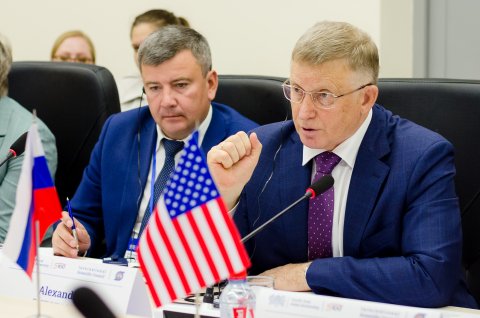On May 31, International Scientific Council discussed the strategy of South Ural State University’s development in the sphere of Materials Science.
Within the meeting with foreign scientists, three key directions which presently are being actively developing at SUSU were introduced: Metals and Alloys, Composite Materials and Magnetic Materials. It is today already that large-scale research projects are being implementing in these directions, and research articles on these topics get published in high-rank international journals.
“We singled out several key projects within these directions. For example, if we are to speak about Metals and Alloys, they are high entropy materials (consisting of 4 or more components), which are of interest for scientists as they possess a number of unique properties; also, they are amorphous alloys, the additive technologies which include both manufacture of materials and development of production processes. We singled out several projects in the sphere of composite materials: they are protective structures, hybrid composites for construction applications, and functional materials for protection of electronics against external exposure as well as provision of electromagnetic compatibility. In the sphere of magnetic materials, our university is implementing projects targeted at development of materials for electronics. These research determine the future, and if we don’t work in these directions today, we won’t be able to move forward,” notes Associate Professor, research engineer of the Department of Engineering Mechanics at the SUSU Institute of Engineering and Technology, Oleg Kudryavtsev.
.jpg)
Scientists of the International Scientific Council highly praised the strategy of SUSU’s research in the sphere of Materials Science, and provided recommendations regarding the projects under implementation. However, it is nowadays that large-scale projects have already been implemented within the frameworks of each of the directions.
For example, scientists invented a new structure of a pneumatic cylinder made of ultra-strong and light materials of the new generation. The pneumatic cylinder’s shell made of polymer composites (glass- and carbon fiber and other materials) will weight almost three times less than a compatible-by-strength metallic one. In this regard, the structure of the new pneumatic cylinder has good outlooks not just for aircraft or rocket engineering but also for surface and underwater boatbuilding, where the minimal weight of the structure is important.
Graphite-reinforced plastic is also among the most perspective modern materials. It is obtained out of graphite and a polymer binder. Advantages of the material are its light weight (the material is three times lighter that titanium), high strength, heat resistance and electrical conductivity. Presently, scientists developed a production process model which allows obtaining necessary parameters for material processing in order to produce a high-strength item with set properties out of it. Today, it is used in military and civil aviation as well as in production of slip elements for electric transport.
Moreover, SUSU scientists are researching functional properties of strontium hexaferrite, a magnetic material which can be used as a functional element for mechanical- and instrument engineering. Monocrystals are of interest for the industry because they are capable of ensuring the high level of end product’s quality. They also have a wide range of application and the minimal number of defects.
Materials Science is one of the prioritized researcher directions of development at South Ural State University together with Digital Industry and Ecology. Today the university is implementing projects on invention of unique materials and high-quality alloys and their application. However, research is being carried out in other spheres of material science as well and include improvement of production processes, disposal of wastes of metallurgical manufacture, which are hazardous for the environment, and many others.




